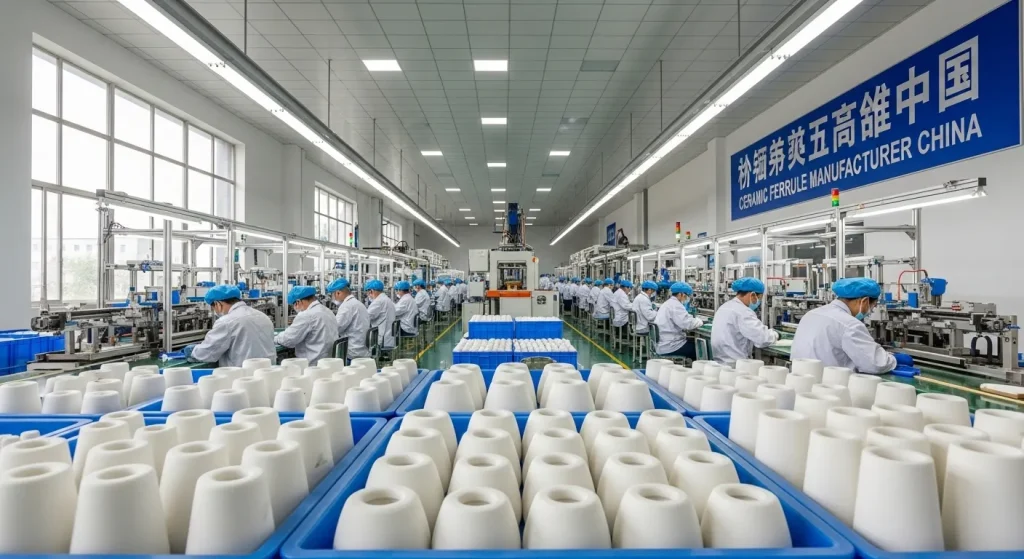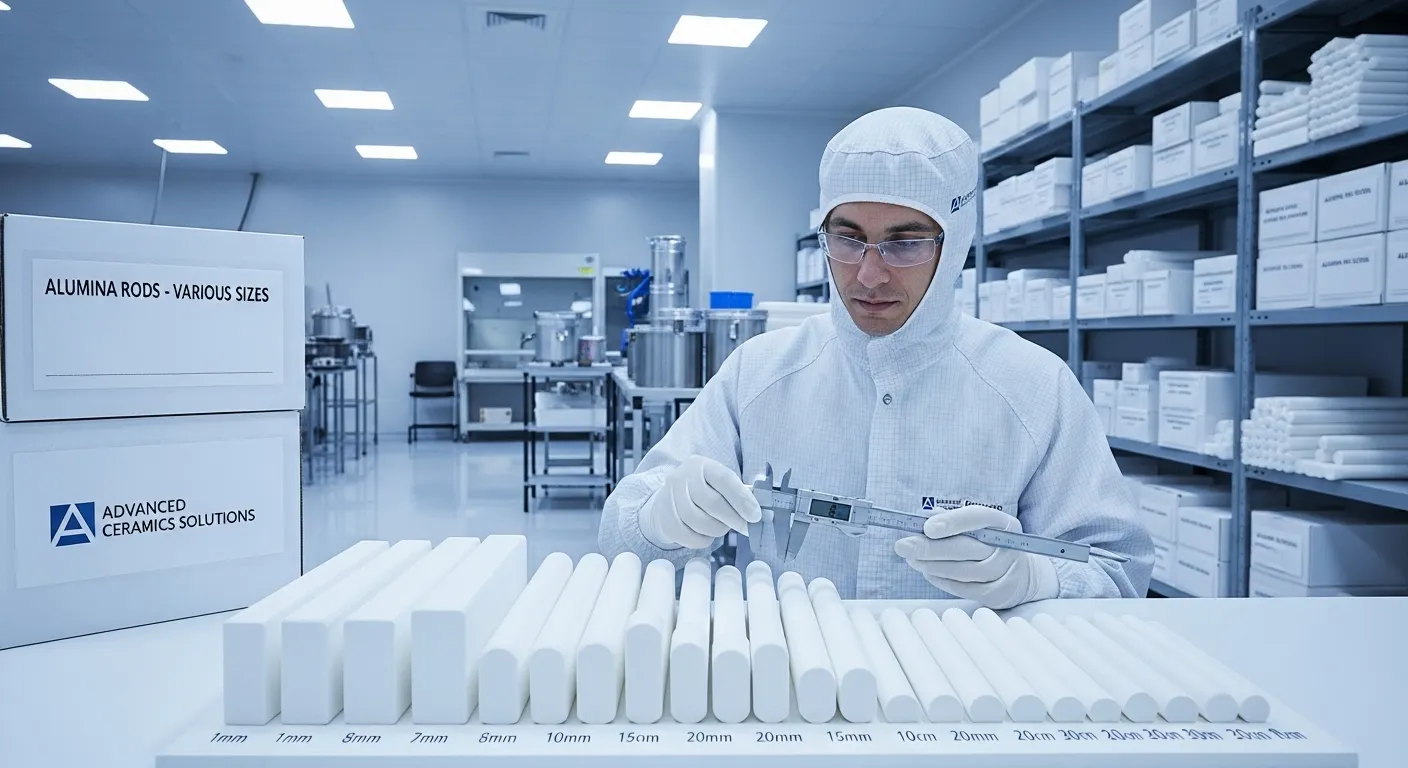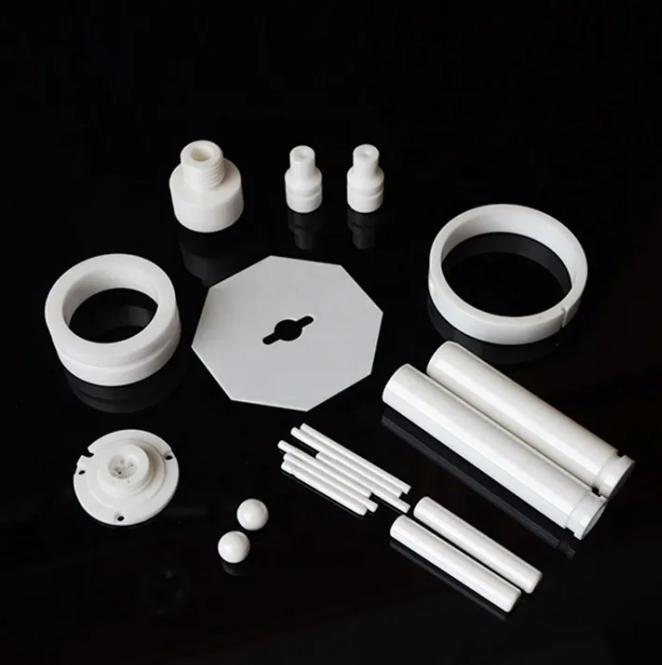Ceramic Ferrule Manufacturer China
A premier ceramic ferrule manufacturer China is a cornerstone of the global fiber optics industry. These specialized companies produce the single most critical component for data transmission. The ceramic ferrule is a high-precision pin. It is the heart of every fiber optic connector. Its quality determines the performance of our entire digital world. Manufacturers in this region have cultivated unparalleled expertise. They have scaled production to meet staggering global demand.

These manufacturers are not just producers. They are masters of sub-micron precision. They have optimized complex manufacturing processes. This allows them to create billions of components. Each component must meet identical, microscopic tolerances. This article explores the technology, processes, and quality systems. We will cover what defines a top-tier ferrule manufacturer.
What Is a Ceramic Ferrule?
A ceramic ferrule is a small, rigid cylinder. It has a microscopic hole, or "bore," through its exact center. Its sole function is to hold and align a single optical fiber. It is the white, polished pin visible at the tip of a fiber optic connector. When two connectors are mated, these ferrules press together. They align the fiber cores. This allows light to pass from one fiber to the other with minimal loss.
The Core Component of Fiber Optic Connectors
The ferrule is the primary alignment mechanism. It is the single most important part for connector performance. They protects the delicate glass fiber. It provides a durable, stable end-face for polishing. Without the ferrule, a reliable, low-loss connection is impossible. Its invention was a key breakthrough for telecommunications.
Defining Sub-Micron Precision
The precision required is almost unimaginable. A single-mode fiber, the standard for high-speed data, has a light-carrying core of just 9 microns (µm). The ferrule's bore must be perfectly centered. An error of just one micron can cause significant signal loss. The ferrule must hold the fiber with an accuracy of less than a human blood cell. This is why it is a high-technology component. A complete ceramic ferrules guide can explain this in more detail.
The 2.5 mm and 1.25 mm Standards
Ferrules are defined by their outer diameter (OD). Two standards dominate the industry.
- 2.5 mm Ferrules: This is the original, larger standard. It is used in robust connectors like the SC, ST, and FC.
- 1.25 mm Ferrules: This is the smaller, modern standard. It is used in high-density connectors like the LC and MU. Its small size allows for more connections in the same space.
A top ceramic ferrule manufacturer China produces both sizes in massive quantities.
The Role of Zirconia in Ferrule Manufacturing
The material choice for a ferrule is non-negotiable. The entire industry relies on one material: Yttria-Stabilized Zirconia (Y-TZP). This is an advanced technical ceramic. It is the only material that offers the perfect balance of properties.
Why Zirconia (Y-TZP) is the Standard
A zirconia ceramic ferrule is the standard for three key reasons.
- Hardness: Zirconia is exceptionally hard. It does not scratch, wear, or deform. This is vital for the polished end-face. It can be mated thousands of times without degrading.
- Toughness: Unlike most ceramics, Y-TZP is not brittle. It has a high fracture toughness. It can absorb stress and impact.
- Thermal Stability: This is its most unique trait. Zirconia's coefficient of thermal expansion is very close to that of glass optical fiber. This means as temperatures change, the ferrule and the fiber expand and contract at similar rates. This prevents the fiber from breaking.
Material Properties and Performance
These properties directly translate to network performance.
- Hardness ensures low insertion loss over a long life.
- Toughness prevents failure during handling and mating.
- Thermal Stability guarantees a reliable connection. This is true in a hot data center or a cold outdoor cabinet.
The Science of Zirconia
Zirconia is a product of advanced ceramic engineering. It is not a natural mineral in this form. It is a synthesized material. The yttria is added to stabilize the zirconia's crystal structure at room temperature. This is what gives the material its unique toughness. The manufacturing of this powder is a complex process.
Manufacturing at Scale: The Ceramic Ferrule Process
A ceramic ferrule manufacturer China excels at this process. They have scaled it to an art form. It turns a fine powder into a sub-micron precision part.
Step 1: Material Formulation
The process begins with ultra-pure Y-TZP powder. This powder has a particle size in the nanometer range. It is mixed with a proprietary polymer binder. This creates a feedstock material. The binder acts as a temporary glue. It allows the powder to be molded.
Step 2: Ceramic Injection Molding (CIM)
The feedstock is heated until it has a paste-like consistency. It is then injected under high pressure into a multi-cavity steel mold. This mold has the shape of the ferrule. It is, however, about 20% larger than the final part. This is to account for shrinkage. This process creates the "green part."
Step 3: Debinding and Sintering
This is the most critical and time-consuming stage.
- Debinding: The green part is placed in a furnace. It is heated very slowly. This process carefully burns away the polymer binder. This must be done gradually, or the part will crack.
- Sintering: The temperature is then raised to over 1,400°C. The part is now just porous zirconia. At this heat, the zirconia particles fuse. The part shrinks by a precise amount. It becomes incredibly hard, dense, and chemically stable.
Step 4: Precision Grinding (Achieving the OD)
After sintering, the ferrule is hard, but its dimensions are not yet perfect. It must be finished. A centerless grinder is used. This machine uses diamond wheels. It grinds the outer diameter to its exact 2.5 mm or 1.25 mm size. The tolerance is often ±0.0005 mm (half a micron).
Step 5: Lapping the Sub-Micron Bore
This is the most difficult and proprietary step. The microscopic hole in the center must be finished. A precision wire, coated in diamond slurry, is often used. It "laps" the inner hole. It removes material one nanometer at a time. This step establishes the final inner diameter. It also ensures the hole is perfectly straight.
Step 6: Final Inspection and Metrology
Every single ferrule is inspected. This is not batch sampling. 100% of the parts are checked. Automated systems use air gauges, lasers, and video cameras. They check the ID, OD, and concentricity. Any part that is not perfect is discarded.
Quality and Consistency in High-Volume Manufacturing
The biggest challenge is not making one perfect ferrule. It is making one million perfect ferrules. A top ceramic ferrule manufacturer China is defined by this capability.
The Challenge of Mass Production
Maintaining sub-micron tolerances over millions of parts is difficult. It requires total control over the process. The powder purity must be consistent. The mold temperatures must be stable. The sintering profiles must be exact. The lapping tools must be monitored.
ISO 9001: The Standard for Quality Management
This is the baseline for a professional manufacturer. An ISO 9001:2015 certification is a must. It is not a product certificate. It is a process certificate. They prove the manufacturer has a documented, audited Quality Management System. It ensures traceability, consistency, and a commitment to continuous improvement.
Key Performance Metrics
Quality is defined by numbers.
- Inner Diameter (ID): For 125 µm fiber, the ID is 126 µm. The tolerance is ±1.0 µm or less.
- Outer Diameter (OD): The tolerance is ±0.5 µm or less.
- Concentricity: This is the most critical metric. It is the offset of the hole's center from the OD's center. A premium ferrule has a concentricity of less than 1.0 µm.
Metrology: The Tools of Precision
A top manufacturer invests heavily in their metrology lab.
- Air Gauges: These are used to measure the ID. They are fast and non-contact.
- Interferometers: These are used to check the end-face geometry after polishing.
- Video Inspection Systems: These high-speed cameras measure concentricity.
Why Global Companies Source from China-Based Manufacturers
Companies all over the world rely on these manufacturers. This is due to a combination of factors.
Unmatched Scale and Capacity
The scale of production is unmatched. A large ceramic ferrule manufacturer China can produce tens of millions of ferrules per month. This capacity is essential to fuel the global demand. It allows data centers and 5G networks to be built quickly.
A Mature and Optimized Supply Chain
The entire supply chain is optimized. This includes raw material sourcing, powder processing, and tool making. This vertical integration is highly efficient. It has been developed over decades. This efficiency allows them to produce high-quality parts at a competitive cost.
Advanced Technological Investment
These are not low-tech factories. They are highly automated, advanced manufacturing centers. We use robots. They use AI-powered vision systems for inspection. It invests heavily in R&D. This improves the process and the product.
Expertise in High-Volume Precision
There is a deep pool of "know-how." The engineers and technicians are experts. They understand the nuances of ceramic injection molding. They know how to control the sintering process. This expertise is a significant competitive advantage.
Custom Ceramic Ferrule Capabilities
While standard ferrules are the bulk of the business, many manufacturers also offer custom solutions.
Beyond Standard Components
A custom ferrule is any part that deviates from the 1.25 mm or 2.5 mm standards. This could be a different length. It could be a different diameter. It could have multiple bores.
The Market for custom-ceramic-ferrule-china
There is a growing market for custom-ceramic-ferrule-china. Manufacturers here can leverage their existing expertise. They can create tooling for new designs. They can do this more quickly and cost-effectively than many other regions.
Applications for Custom Parts
Custom ferrules are used in many advanced fields.
- Medical Devices: Endoscopes and surgical laser tools.
- Sensing: Fiber optic sensors for temperature or pressure.
- Research: Physics labs and universities.
- Multi-Fiber: Custom ferrules with 2, 4, or 8 bores.
The Co-Engineering Process
A good manufacturer will work with the customer. The customer provides a drawing. The manufacturer's engineers will review it. They will provide feedback on manufacturability. This co-engineering process is key to a successful custom part.
The Global Context of Ferrule Sourcing
The ferrule is a truly global component. A ceramic ferrule manufacturer China is a key player in this market.
A Worldwide Demand for Connectivity
Every region is building out its fiber network. This creates a massive, stable demand for ferrules. This component is essential for modern life.
Comparing Manufacturing Hubs
Different regions have different strengths.
- The ceramic-ferrules-usa market often focuses on high-specification, military, and medical applications.
- The ceramic-ferrule-uk market serves as a key hub for European distribution and standards.
Balancing Cost, Quality, and Volume
A manufacturer in this region often provides the best balance of all three. They have mastered the technology. This allows them to produce high-quality parts. They have achieved massive scale. This allows them to offer a competitive price. This combination is very powerful.
How to Evaluate a Ceramic Ferrule Manufacturer
Choosing a partner is a critical decision.
- Look Beyond the Price Tag: A ferrule that is 10% cheaper but 50% less reliable is a disaster. Quality is the most important factor.
- Ask for Technical Specifications: Demand a datasheet. This datasheet must list the ID, OD, and concentricity.
- Verify ISO 9001 Certification: This is the baseline for trust. Do not work with a manufacturer who is not certified.
- Request Samples for Testing: The ultimate proof is the part itself. Get samples. Inspect them. Test them in your connectors.
- Assess Communication and Support: A good partner is responsive. They have engineers who speak your language. They can answer technical questions.
Conclusion
A ceramic ferrule manufacturer China is more than a supplier. They are a foundational partner for the entire global technology industry. It have mastered the complex science of ceramic engineering. They have scaled it to a level that was once thought impossible. The precision, quality, and volume they produce are what allow us to build a connected world. Choosing the right manufacturer is a critical strategic decision. It is an investment in quality and reliability.
In This Article
- 1 What Is a Ceramic Ferrule?
- 2 The Role of Zirconia in Ferrule Manufacturing
- 3 Manufacturing at Scale: The Ceramic Ferrule Process
- 4 Quality and Consistency in High-Volume Manufacturing
- 5 Why Global Companies Source from China-Based Manufacturers
- 6 Custom Ceramic Ferrule Capabilities
- 7 The Global Context of Ferrule Sourcing
- 8 How to Evaluate a Ceramic Ferrule Manufacturer
- 9 Conclusion
 English
English 中文
中文





